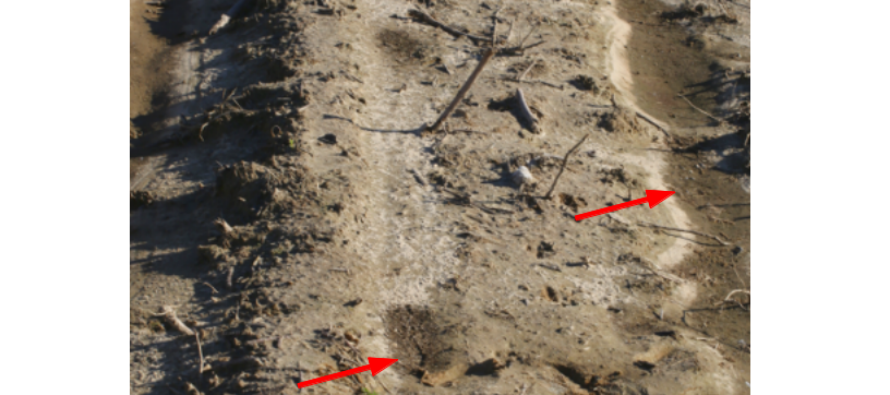Peanut Emergence and Seed Diseases

John Byrd of Clint Williams (top) and Jason Sarver (bottom), Mississippi State University’s new peanut specialist, looking at seed.
At planting time there are never enough hours in the day, or enough days between the last rain and the next rain. Especially when the weather has pushed the last possible planting date for the crop into “next week’. So sometimes we try to get seeds into the ground even when conditions are not right.
Recommended peanut planting conditions
New planting recommendations are that peanuts should be planted in soils that have been at 70°F for three or more days. This recommendation is based on a newer study which increases the recommended soil temperature from 65° F.
Lower soil temperatures increase the time it takes for the seed to germinate and emerge from the soil. Meanwhile the little bit of seed treatment is wearing away, allowing pathogens and insects to eat away at that seed, chock filled with good protein and oil.
Ideally, planting depth should match soil moisture. Recommended depth ranges from 1.5 to 2.5 inches.
This is really the first week of the season which good planting conditions have been met.
Current peanut emergence problems
Peanuts that were planted before this week are experiencing emergence problems because of cold soil temperatures and rain. This week we have looked at a number of fields in which the peanuts have not yet emerged and where some of the seed are decaying, especially in areas where water stood in the field for extended periods of time.
The good news is that most peanut seed we have looked at to this point is going to emerge. The increasing soil temperatures that Mississippi is currently experiencing should entice many of these seed from the ground by the end of the week.
Only seed in wetter areas seem to be having problems. The problems are from diseases incited by the combination of cool temperatures and wet soils (see later).
What to do if your peanut seed are having trouble emerging
-
Wait until the warmer soil temperatures that this last week brought to have an affect
-
If your seed were planted within the previous several weeks, they should be showing some ground crack by now.
-
If emergence in low areas is determined to be poor, replanting might be a viable option.
-
Research at the University of Georgia has shown that yield potential is lost in single rows at stands of 2.5 plants per foot of row and below.
-
In those same studies, yield benefits resulted from adding seed to stands below 2.5 plants per foot of row.
-
If you do replant, adding seed next to the original row has shown to nearly always be a better option than destroying the initial stand and completely replanting. If the replanting operation occurs with 3-4 weeks after the initial planting date, maturity differences at harvest will be present but not large enough to discourage replanting.
-
Spot replanting will likely be a favorable option. If some areas of the field have an adequate stand while others are poor, adding seed in only the poor areas will save time and money. Again, yield benefits will likely outweigh maturity differences, especially considering this year’s early-planted seed is taking so long to emerge.
-
When replanting, use one of the fungicides labeled for in-furrow use (link URL).
-
-
What if my soil is crusted over?
There have been a few questions coming in about using a rotary hoe to try to aid emergence. In all cases, the fields I have gone to look at are going to emerge without assistance. A peanut plant has an impressive ability to push through soil conditions that many other crops could not push through. This ability is magnified if a sufficient seeding rate (approximately 6 seeds per foot) has been used, with those young seedlings working together to push through crusted soils.
Seed and seedling emergence disease examples
Most seed losses were occurring in low areas, in areas with heavier soils, or in small spots of the row that were slightly lower than the surrounding area (Figures 1 and 2).
Figure 1 (top). A typical low area in the field where water and cool soil temperatures created conditions right for seed disease. Figure 2 (bottom). Small spot areas along the seed row that are low enough to collect water from the immediate area. Seed that had been planted for several weeks in areas such as this were starting to decay, but seed in the dry areas to either side seemed to be fine.
A 2011 survey of seed diseases in the field found most of them caused by a fungus called Rhizopus (about 51%), and Pythium (33%). In warmer weather more Aspergillus niger and A. flavus-like fungi (66%) and Macrophomina (13%) were found.. Most rotting seeds were infected with multiple pathogens.
This last week, Rhizopus and Pythium seemed to dominate, associated with a very smelly (like the rotting potato under your sink) Erwinia -like bacteria decay. It was impossible to tell which pathogen was doing what and who came first. Figures 3 and 4 show some of seed decay symptoms.
Figure 3 (above). Rhizopus (fungal) rot of seed. Figure 4 (bottom) Rhizopus, Pythium, and Erwinia-like bacterial decay of a seed. Erwinia decay odor is distinctive, smelling like that rotting potato under the sink.









Let me tell You a sad story ! There are no comments yet, but You can be first one to comment this article.
Write a comment